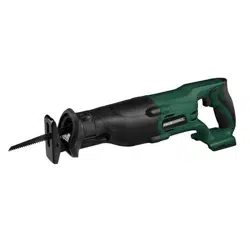Loading ...
Loading ...
Loading ...

Page 12
WARNING:
Before attach the battery
pack on the tool, always check to determine
that the switch performs properly and
returns to the “OFF” position when released.
WARNING:
Hold the tool only by the
plastic handle and the insulated grip area to
help prevent electrical shock. When sawing
into walls or oors you may encounter
electrical wiring. Sawing into a “live” wire will
cause electric shock.
1. Remove the battery pack from the saw.
2. Make sure that the workpiece is
firmly clamped.
3. Use the appropriate type and size
of blade for the workpiece material
and size.
4. Adjust the pivot shoe as necessary to
make sure that the blade will extend
beyond the shoe and the workpiece at
all times.
5. Adjust the pivot shoe as necessary to
expose unworn blade teeth for longer
blade life.
6. Check for clearance behind the
workpiece so that the blade will not impact
another surface.
7. Mark the line of cut clearly. If cutting
metal, apply cutting oil on the line.
8. Attach the battery pack on the saw.
9. Hold the saw firmly with both hands.
Make sure to keep your hands on the
insulated gripping areas only.
10. Depress the lock-off button and trigger
switch to start the saw and bring it to the
maximum desired cutting speed before
applying the blade to the workpiece.
11. Do not force the tool. Place the shoe
firmly on the workpiece while cutting.
Use only enough steady pressure on the
blade to keep the saw cutting.
12. Reduce pressure as the blade comes to
the end of the cut.
13. Allow the saw to come to a complete
stop before removing the blade from
the workpiece.
14. If sawing fiberglass, plaster, wallboard,
or spackling compound, clean the saw
motor vents frequently with a vacuum
or compressed air. These materials are
highly abrasive and may accelerate the
wear on motor bearings and brushes.
NOTICE: Cutting speeds should vary with
the workpiece. Hard materials, such as
metals, require lower speeds; for softer
materials use higher speeds.
WARNING:
Do not allow familiarity
with the saw to make you careless. One
careless fraction of a second is enough to
inict serious injury.
PLUNGE CUTTING (FIG. 7)
FIG. 7
Your reciprocating saw is ideal for plunge
cutting directly into surfaces that cannot be
cut from an edge, such as walls or floors.
Plunge cutting may be done two ways
depending on how the blade is inserted.
Column A shows how to plunge cut with the
teeth of the blade facing down. Column B
shows how to plunge cut with the teeth of
the blade facing up.
A B
OPERATION
Loading ...
Loading ...
Loading ...
